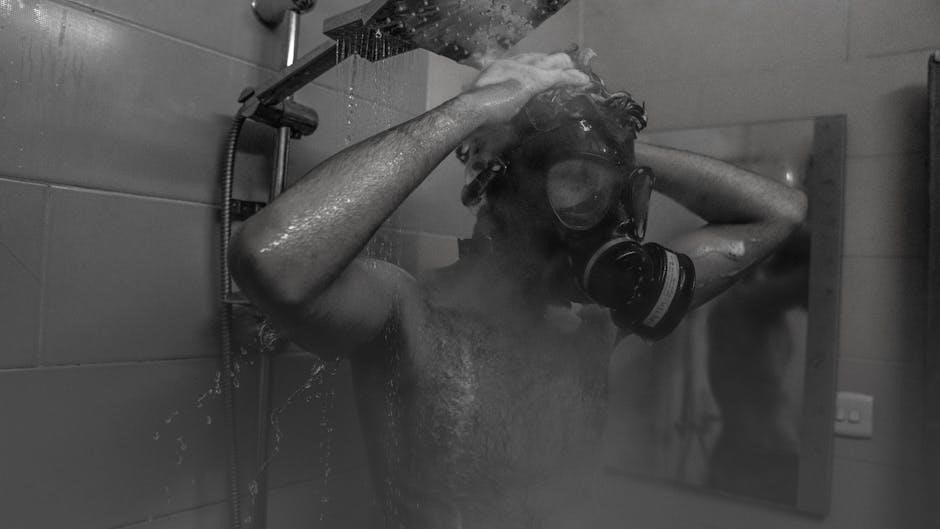Welcome! This guide offers a roadmap to safety in an uncertain world․ Master essential prepping for any emergency․ Learn vital survival skills․ Prepare for crises, from blackouts to shortages․ Discover self-sufficiency secrets․ Start prepping today!
Understanding Prepping
Prepping: More Than Just Doomsday Scenarios
Prepping, at its core, is about proactive preparedness․ It’s not solely about apocalyptic events, but rather about developing resilience to handle a wide range of potential disruptions, from natural disasters to economic instability․ It’s about taking control of your safety and well-being by planning ahead․
The Core Principles
Understanding prepping begins with embracing its core principles․ These principles include self-reliance, resourcefulness, and community support․ Self-reliance means being able to meet your basic needs without relying on external aid․ Resourcefulness involves finding creative solutions to problems with limited resources․ Community support means working together with others to enhance collective resilience․
Why Prepping Matters
In an unpredictable world, being prepared offers peace of mind․ Knowing you have a plan and the resources to handle emergencies reduces stress and anxiety․ Prepping also fosters a sense of empowerment, allowing you to take charge of your destiny․
Debunking Myths
Many misconceptions surround the term “prepper․” It’s not about paranoia or living in fear․ It’s about being responsible and proactive in safeguarding yourself and your loved ones․ Preppers come from all walks of life, united by a common desire to be prepared for whatever the future may hold․
Getting Started
Understanding prepping also involves identifying your specific needs and vulnerabilities․ What are the most likely threats in your area? What resources do you already have? What skills do you need to acquire? Answering these questions will help you create a personalized prepping plan․
The Prepper Mindset
The prepper mindset is characterized by a proactive approach to risk management․ It involves assessing potential threats, developing mitigation strategies, and continuously learning and adapting․ It’s about being prepared, not scared․
The Importance of Information
Staying informed is crucial for effective prepping․ Follow news and weather reports, research potential threats, and learn from the experiences of others․ The more you know, the better prepared you’ll be․
Building a Foundation
Prepping isn’t a sprint; it’s a marathon․ Start with the basics: food, water, shelter, and first aid․ Gradually expand your preparedness efforts as you gain knowledge and resources․
Community Involvement
Connecting with other preppers can provide valuable support and knowledge; Share resources, learn from each other’s experiences, and build a network of like-minded individuals․
Continuous Learning
Prepping is an ongoing process․ Stay updated on new threats and technologies, refine your skills, and adapt your plans as needed․ The world is constantly changing, and your preparedness efforts should evolve with it․

Essential Prepping Skills
Mastering key skills is vital․ Learn water purification for safe drinking․ Practice food storage to combat shortages․ Build shelters for protection․ Sharpen first aid for emergencies․ Acquire self-defense for security․ Boost your survival knowledge today!
Water Purification
Clean water is crucial for survival․ Learn multiple purification methods to ensure a safe water source․ Boiling is effective; bring water to a rolling boil for at least one minute to kill harmful bacteria and viruses․ Chemical treatment using purification tablets containing chlorine dioxide or iodine is another option, following the manufacturer’s instructions carefully․ Filtration is a valuable skill; portable water filters can remove sediment, bacteria, and protozoa․ Constructing a DIY filter using layers of cloth, charcoal, sand, and gravel can provide basic filtration in emergency situations․ Solar disinfection (SODIS) is a simple method: fill clear plastic bottles with water and leave them in direct sunlight for at least six hours․ Remember to always pre-filter water to remove sediment before using any purification method for best results․ Mastering these techniques will ensure access to safe drinking water, a cornerstone of preparedness․ Understanding these diverse methods empowers you to adapt to any situation and secure this life-sustaining resource․ Practice each technique to build confidence and proficiency․ Your health and survival depend on it․ Develop a comprehensive approach to water purification, combining multiple methods for added safety․ Store purification supplies in your bug-out bag and home emergency kit․ Knowledge and preparation are your greatest assets in securing clean water during a crisis․
Food Storage
Building a resilient food storage system is essential for long-term survival․ Focus on non-perishable foods with long shelf lives, such as canned goods, dried beans, rice, pasta, and grains․ Proper storage is critical; use airtight containers to protect food from moisture, pests, and temperature fluctuations․ Rotate your stock regularly, using the “first in, first out” (FIFO) method to prevent spoilage․ Store food in a cool, dark, and dry place, ideally between 50-70°F (10-21°C)․ Consider freeze-dried foods for their extended shelf life and nutritional value․ Learn about food preservation techniques like canning, dehydrating, and pickling to extend the life of fresh produce․ Include a variety of foods in your storage to ensure a balanced diet․ Calculate your family’s caloric needs and plan accordingly, aiming for at least a three-month supply of food․ Store water along with your food supply, as water is essential for cooking and hydration․ Consider the specific dietary needs of your family members, including allergies and medical conditions․ Don’t forget essential cooking supplies like a manual can opener, utensils, and a portable stove․ Regularly inspect your food storage for signs of spoilage or infestation; Supplement your food storage with gardening and foraging skills to provide fresh produce in a survival situation․ By carefully planning and maintaining your food storage, you can ensure your family has access to nourishment during challenging times․ Remember to include comfort foods to boost morale and maintain mental well-being․

Building a Survival Shelter
Constructing a reliable survival shelter is paramount for protection from the elements․ Prioritize location: choose a site sheltered from wind, rain, and extreme temperatures, while considering access to water and resources․ Natural shelters, like rock overhangs or dense trees, can provide a foundation․ Learn to build various shelter types, including lean-tos, debris huts, and snow caves, adapting to the available materials and environment․ A lean-to is a simple structure built with a sloping roof against a tree or rock, offering quick protection from rain and wind․ Debris huts provide insulation using layers of leaves, branches, and other natural materials․ Snow caves offer warmth in cold environments by trapping body heat․ Insulation is key; use leaves, pine needles, and other materials to create a barrier against the cold and moisture․ Consider the size of your shelter; it should be large enough to accommodate your group comfortably but small enough to conserve heat․ Ensure proper ventilation to prevent condensation and carbon monoxide buildup if using a fire inside․ Practice building shelters in different environments to develop your skills and adapt to varying conditions․ Carry essential shelter-building tools in your survival kit, such as a knife, axe, saw, and cordage․ Learn to identify poisonous plants and avoid using them in your shelter construction․ Consider the presence of wildlife and choose a location that minimizes the risk of encounters․ Regularly maintain your shelter to ensure its integrity and effectiveness․ By mastering shelter-building techniques, you can increase your chances of survival in any environment․ Remember to prioritize safety and stability when constructing your shelter․

Creating a Bug-Out Bag
A bug-out bag is essential for rapid evacuation․ Pack vital supplies for survival away from home․ Include food, water, first aid, and shelter․ Choose a durable, comfortable backpack․ Organize items for easy access․ Regularly check and update your bag․ Be ready to go!
Essential Items for Your Bag
Water and Filtration: Pack at least three liters of water per person per day․ Include a high-quality water filter or purification tablets to ensure access to safe drinking water from natural sources․ Consider a durable, collapsible water container for easy storage and transport․
Food Supplies: Choose non-perishable, high-calorie foods that require minimal preparation․ Options include energy bars, dried fruits, nuts, canned goods, and freeze-dried meals․ Aim for a three-day supply per person․ Don’t forget a manual can opener!
First Aid Kit: A comprehensive first aid kit is crucial․ Include bandages, antiseptic wipes, pain relievers, gauze pads, medical tape, scissors, tweezers, and any personal medications․ A first aid manual can be invaluable for treating injuries and illnesses․
Shelter and Warmth: Pack a lightweight emergency blanket or bivy sack for protection from the elements․ A small tent or tarp can provide more substantial shelter․ Include a fire starter (waterproof matches, lighter, or ferro rod) and tinder for building a fire for warmth and cooking․
Navigation Tools: A map and compass are essential for navigating unfamiliar terrain․ Learn how to use them effectively․ A GPS device can be helpful, but it relies on batteries and satellite signals․ Consider a solar charger for electronic devices․
Lighting: Pack a headlamp or flashlight with extra batteries․ A hand-crank or solar-powered light is a reliable alternative․
Tools and Repair Items: A multi-tool or knife is indispensable for various tasks․ Include duct tape, paracord, and a small repair kit for fixing gear․
Hygiene Items: Pack essential hygiene items such as hand sanitizer, soap, toothbrush, toothpaste, toilet paper, and feminine hygiene products․
Communication Devices: A two-way radio can be used to communicate with others in your group or to monitor emergency broadcasts․ Consider a whistle for signaling for help․
Personal Documents: Include copies of important documents such as identification, insurance cards, and medical records․ Store them in a waterproof bag․
Cash: Keep a supply of small bills for situations where electronic payments are not possible․
Self-Defense Items: Depending on your location and personal preferences, consider including a self-defense item such as pepper spray or a knife․ Familiarize yourself with local laws regarding self-defense․
Clothing: Pack extra clothing appropriate for the climate and potential weather conditions․ Include moisture-wicking base layers, a waterproof jacket, and sturdy footwear․
Remember to customize your bug-out bag to meet your specific needs and location․ Regularly review and update the contents to ensure they are in good condition and relevant to your current circumstances․
First Aid and Medical Preparedness
Comprehensive First Aid Kit: Assemble a well-stocked first aid kit that goes beyond basic supplies․ Include items like various sizes of bandages, sterile gauze pads, medical tape, antiseptic wipes, antibiotic ointment, pain relievers (ibuprofen, acetaminophen), antihistamines, burn cream, scissors, tweezers, a CPR mask, and nitrile gloves․ Consider adding specialized items like a tourniquet, hemostatic gauze, and a suture kit if you have the training to use them․ Ensure all medications are within their expiration dates and stored properly․
Medical Training: Invest in first aid and CPR training․ Consider advanced wilderness first aid or emergency medical technician (EMT) courses for more in-depth knowledge․ Hands-on training is invaluable for handling medical emergencies in a survival situation․ Practice your skills regularly to maintain proficiency․
Personal Medications: Store a sufficient supply of any prescription medications you or your family members require․ Keep a list of all medications, dosages, and allergies․ If possible, obtain extra prescriptions from your doctor to build a longer-term supply․ Properly store medications to protect them from heat, moisture, and light․
Medical Reference Materials: Include a comprehensive first aid manual or medical reference guide in your kit․ A pocket-sized guide can be useful for quick reference in the field․ Consider downloading medical information onto a tablet or smartphone for offline access․
Dental Care: Pack dental supplies such as a toothbrush, toothpaste, floss, and dental wax․ Learn basic dental emergency procedures, such as treating a toothache or a lost filling․ Consider including dental repair materials in your kit․
Water Purification: Contaminated water sources can lead to serious illnesses․ Include water purification tablets or a portable water filter in your medical kit․ Learn how to properly purify water from various sources․
Hygiene and Sanitation: Maintain good hygiene to prevent the spread of infection․ Pack hand sanitizer, soap, wet wipes, and toilet paper․ Dispose of waste properly to avoid contaminating water sources․
Wound Care: Proper wound care is essential to prevent infection․ Clean wounds thoroughly with soap and water or antiseptic wipes․ Apply antibiotic ointment and cover with a sterile bandage․ Monitor wounds for signs of infection, such as redness, swelling, and pus․
Herbal Remedies: Research and learn about medicinal plants that grow in your area․ Many plants have natural healing properties that can be used to treat various ailments․ However, be cautious when using herbal remedies and ensure you can properly identify the plants․
Prevention: Focus on preventing injuries and illnesses in the first place․ Wear appropriate clothing and footwear to protect yourself from the elements․ Practice safe food handling techniques․ Get vaccinated against preventable diseases․
Long-Term Considerations: For long-term survival situations, consider learning about basic medical procedures, such as suturing wounds or setting broken bones․ Building a relationship with a doctor or medical professional who understands your preparedness goals can be beneficial․
Mental Health: Medical preparedness also includes mental health․ Stress and trauma can take a toll on your mental well-being․ Learn coping mechanisms and stress management techniques․ Ensure you have access to mental health resources if needed․

Home Defense Strategies
Reinforce Entry Points: Secure your home’s perimeter by reinforcing doors and windows․ Install deadbolt locks on all exterior doors, and consider using security strike plates with longer screws for added strength․ Reinforce windows with security film or replace them with impact-resistant glass․ Trim bushes and trees around windows and doors to eliminate hiding spots․
Security System: Invest in a reliable home security system with features like door and window sensors, motion detectors, and a loud alarm․ Consider a system with professional monitoring for faster response times in emergencies․ Install security cameras to monitor your property and deter potential intruders․
Lighting: Install motion-activated lights around your property to illuminate dark areas and deter intruders․ Ensure adequate lighting around all entry points․ Use timers to turn lights on and off when you’re away from home․
Neighborhood Watch: Participate in or organize a neighborhood watch program to increase vigilance and communication among neighbors․ Share information about suspicious activity and work together to deter crime․
Self-Defense Training: Consider taking self-defense classes to learn basic techniques for protecting yourself and your family․ Learn how to assess threats, de-escalate conflicts, and use physical force if necessary․
Firearms Training: If you choose to own firearms for self-defense, obtain proper training and licensing․ Learn how to safely handle, store, and use firearms․ Practice regularly at a shooting range to maintain proficiency․
Safe Room: Designate a safe room in your home where you and your family can retreat in case of a home invasion or other emergency․ Reinforce the walls and door of the safe room, and stock it with essential supplies like a communication device, first aid kit, and self-defense tools․
Communication Plan: Develop a communication plan with your family members to ensure everyone knows what to do in case of an emergency․ Establish a meeting point outside the home in case you need to evacuate․
Awareness and Observation: Be aware of your surroundings and pay attention to any suspicious activity․ Report any concerns to the police; Trust your instincts and take precautions if you feel unsafe․
Dogs: A well-trained dog can be an effective deterrent to intruders․ Choose a breed known for its protective instincts and train it to bark at strangers․
Landscaping: Use thorny bushes or other natural barriers to create a defensive perimeter around your property․ Avoid landscaping that provides cover for intruders․
Community Support: Build relationships with your neighbors and work together to create a safer community․ Share information and resources, and support each other in times of need․

No Responses